Every time you try to pull a door open, lift your laundry, or even twist off the cap of your water bottle, you wonder why you experience that sharp pain in your elbow. Well, there may be many different reasons why you have elbow pain from lifting. To select the right treatment approach, you need to identify the cause of your pain first. Keep reading to learn more about it.
Identifying the Cause of Elbow Pain
A number of different injuries may lead to elbow pain from lifting. In most cases, you experience this situation due to conditions such as golfer's elbow and tennis elbow. These repetitive strain injuries can cause serious pain and make you pay a visit to a therapist. Here is more about these conditions.
Medial Epicondylitis (Golfer's Elbow)
Location: Inside of the elbow
In this condition, you experience pain to an area where the tendons of your forearm muscles join the bony bump on your elbow. You experience pain due to any damage caused by repeated stress to the tendons or muscles that control your fingers or wrist. Repetitive forceful finger or wrist motions, improper hitting, and repetitive throwing are other common factors contributing to golfer's elbow.
The most common symptom of golfer's elbow is elbow pain from lifting. You notice tenderness on the inner side of your elbow with pain that sometimes extend to the inner side of your forearm. It is also common to experience stiffness in the elbow, weakness in the hands and wrists, and numbness in the ring and little fingers. Your pain is likely to become worse when you swing a golf club, shake hands, pitch a ball, lift weights, turn a doorknob, and flex your wrist.
Lateral Epicondyle (Tennis Elbow)
Location: Outside of the elbow
Tennis elbow is actually swelling of the tendons that lead to pain in the arm and elbow. There are bands of tough tissues called tendons around your elbow that connect the muscles of your lower arm to the bone. Repetitive motions like gripping a racket during a swing can put excessive pressure on the muscles as well as the tendons. That constant pressure may lead to microscopic tears in the tissue, which causes pain and stiffness. Keep in mind that you can get a tennis elbow in sports other than tennis, such as squash, racquetball, and weight lifting.
The most common symptom of this type of tendonitis is tenderness and pain on the outside of your elbow. The precise location of pain is in the bony knob on your elbow, but you may feel pain radiating into the lower or upper arm. The pain is usually severe when you grip an object, lift something, straighten your wrist, or shake hands.
How to Deal with Elbow Pain from Lifting
When you have elbow pain with lifting, you need to identify the underlying cause to find the most appropriate treatment. Here are some treatment options for you to consider:
1. Avoid Anything That Hurts
You need to change the position of your hand and switch to something more comfortable. You can switch to an EZ-curl bar to avoid pain and perform pull-ups with your wrist angled at 45 degrees. Small adjustments will make big difference in relieving your elbow pain from lifting.
2. Do Rotational Exercises
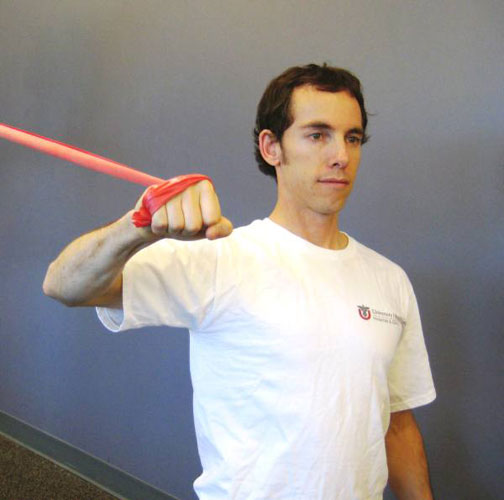 Rotational traction: For this, you need to take an exercise band and attach it to something sturdy. Keep it at your waist height and loop the band to create a split-knot. Now, place your hand through it and slowly row your hand to your side. Be sure to alternate palm up and palm down with every rep. Try 3 sets of 20reps each with 30 seconds rest in between sets.
Rotational traction: For this, you need to take an exercise band and attach it to something sturdy. Keep it at your waist height and loop the band to create a split-knot. Now, place your hand through it and slowly row your hand to your side. Be sure to alternate palm up and palm down with every rep. Try 3 sets of 20reps each with 30 seconds rest in between sets.- Rotational tension: Get a rubber band and loop it around your little finger. Twist it in a way to create another loop and wrap that loop around your ring finger. Now, twist it again in the opposite direction to wrap your middle finger as well. Continue with it until you wrap your thumb as well. Now, splay your fingers against the resistance while bending your elbow at a right angle. Slowly twist your palm until it faces up and then twist until it faces down. Perform 3 sets with 20 reps per set.
3. 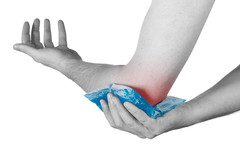 Apply Ice
Apply Ice
You may consider applying ice to reduce swelling. You may experience less pain because the ice can numb the area temporarily. Do not apply ice for more than 15 minutes in one session. Applying ice after activity will help because it reduces any swelling caused by stretches and activity.
4. 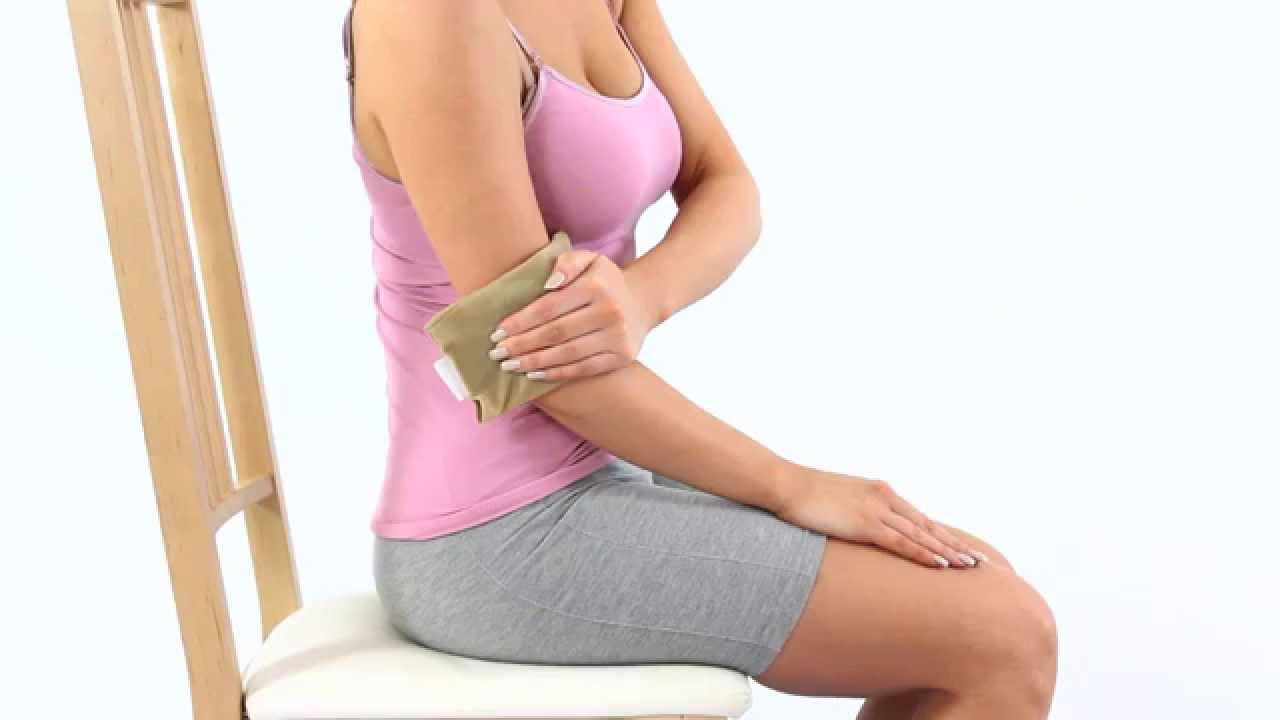 Apply Heat
Apply Heat
Applying heat to your elbow will improve range of motion and help alleviate elbow pain from lifting. Consider applying heat before you do any stretching. Make use of a towel to insulate your heat pack and apply it for no more than 15 minutes.
5. Supplement with Omega-3s
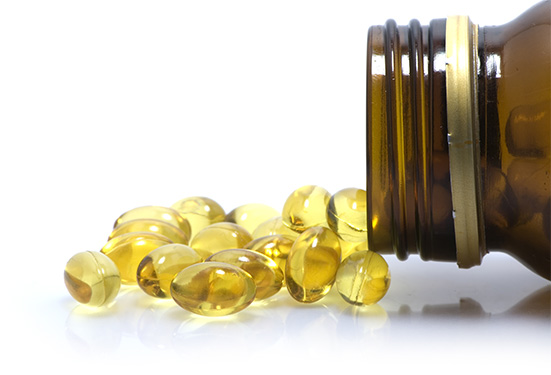 Taking supplements of fish oil or omega-3s helps lower inflammation, which in turn will help reduce swelling. This also prevents formation of scar tissue in the elbow. You can also include walnut, fish, chia seeds, flaxseeds, and other such food that contain omega-3 fatty acids. Simply, sprinkling chia or flax on your salad or breakfast will do.
Taking supplements of fish oil or omega-3s helps lower inflammation, which in turn will help reduce swelling. This also prevents formation of scar tissue in the elbow. You can also include walnut, fish, chia seeds, flaxseeds, and other such food that contain omega-3 fatty acids. Simply, sprinkling chia or flax on your salad or breakfast will do.
6. Do Some Massage
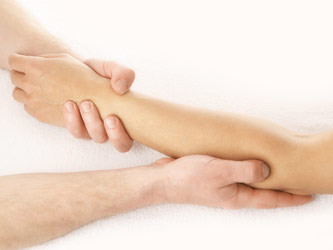 After you have applied heat pack for some time, you should follow it by massaging the area. This improves blood circulation to the area and breaks up adhesions. This also prevents muscle spasms and work well for scar tissue. Apply firm yet comfortable pressure when massaging. Massage your affected area for 10 minutes at least thrice a day.
After you have applied heat pack for some time, you should follow it by massaging the area. This improves blood circulation to the area and breaks up adhesions. This also prevents muscle spasms and work well for scar tissue. Apply firm yet comfortable pressure when massaging. Massage your affected area for 10 minutes at least thrice a day.
